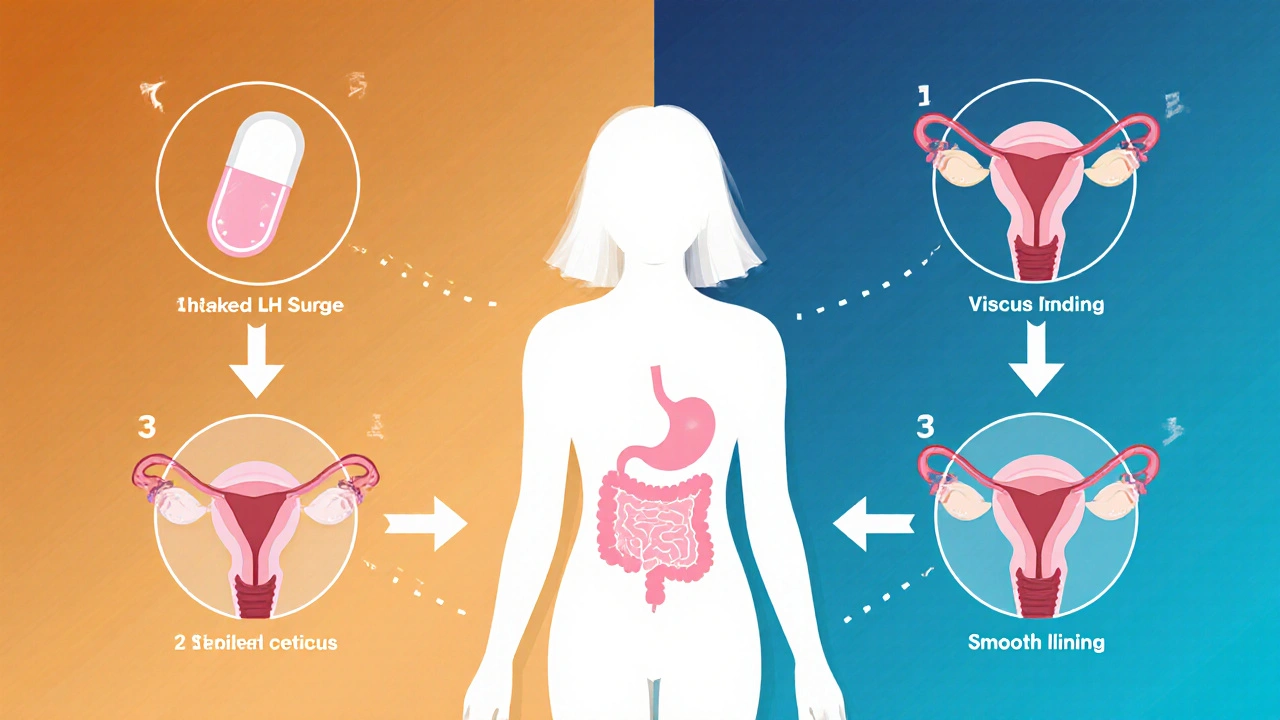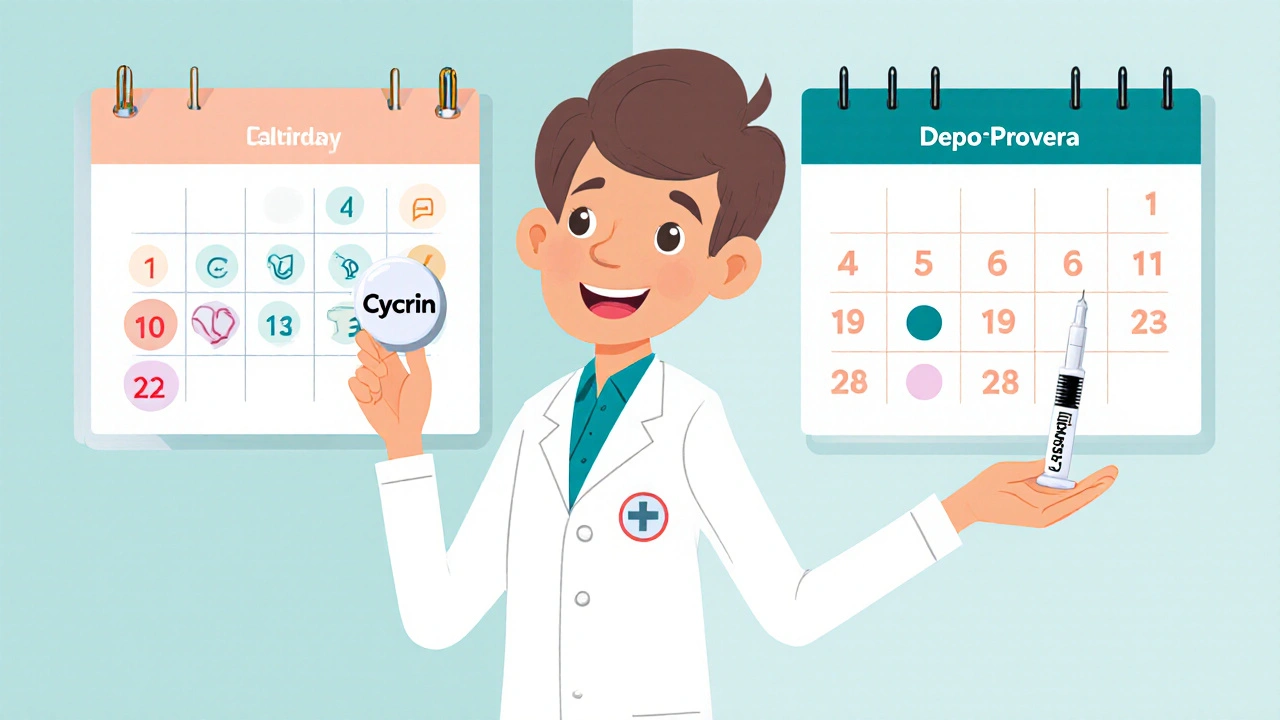Ever wondered why some doctors prescribe a tiny tablet while others opt for a monthly injection? The answer often lies in the subtle differences between progestin drugs. When it comes to managing menstrual disorders, endometriosis, or providing hormonal contraception, choosing the right molecule can change everything.
Cycrin is a brand name for medroxyprogesterone, a synthetic progestin used for a range of gynecological conditions. Its primary action is to mimic natural progesterone, suppressing ovulation and stabilising the uterine lining. If you’re looking for a reliable progestin, Cycrin stands out for its oral dosing convenience and well‑documented safety profile.
What is Cycrin (Medroxyprogesterone) exactly?
Medroxyprogesterone belongs to the class of 17‑α‑hydroxyprogesterone derivatives. It was first synthesized in the 1950s and quickly found its way into both contraceptive and therapeutic formulas. Cycrin is the oral tablet formulation, typically delivered at 5‑10 mg per day for short‑term cycles or 10‑15 mg for long‑term management of conditions like endometriosis.
How does it work in the body?
Once swallowed, medroxyprogesterone is absorbed through the gastrointestinal tract and binds to progesterone receptors in the uterus, breast, and brain. This binding does three things:
- Inhibits the LH surge, preventing ovulation.
- Thickens cervical mucus, making sperm passage difficult.
- Alters the endometrial lining, reducing the risk of breakthrough bleeding.
Because it’s a synthetic analogue, it’s more resistant to metabolic breakdown than natural progesterone, giving it a longer half‑life (about 36 hours) and allowing once‑daily dosing.
Key benefits and side‑effects of Cycrin
Patients often appreciate the predictability of oral dosing, especially when they dislike injections. Clinical studies show Cycrin reduces endometriosis‑related pain by up to 45 % after three months of therapy. It also helps regulate irregular cycles and can be used off‑label for menopausal hormone therapy.
Common side‑effects include mild weight gain, breast tenderness, and occasional mood swings. Rare but serious risks-such as venous thromboembolism-mirror those of other progestins and are more likely in smokers or women over 35.

Major alternatives on the market
When you hear “progestin,” a whole family of molecules comes to mind. Below are the most frequently prescribed alternatives, each with its own strengths.
Depo‑Provera (medroxyprogesterone acetate) is the injectable cousin of Cycrin, delivered as a 150 mg intramuscular shot every 12 weeks. Its depot formulation provides steady hormone levels without daily compliance worries.
Norethisterone is a 19‑nor‑testosterone‑derived progestin, often prescribed as 5‑10 mg tablets for short‑term cycle control. It’s especially popular for treating heavy menstrual bleeding.
Dydrogesterone is a bioidentical progestin that closely mimics natural progesterone, reducing the risk of androgenic side‑effects. It’s typically used in luteal‑phase support for IVF cycles.
Progesterone (micronised oral or vaginal) is the gold‑standard natural hormone. Though it requires larger doses (200‑400 mg) to achieve similar effects, many patients prefer it for its minimal impact on lipid profiles.
Estradiol is not a progestin, but it often pairs with a progestin in hormone replacement therapy (HRT). Understanding its interaction with each progestin helps fine‑tune menopausal symptom control.
Head‑to‑head comparison
| Feature | Cycrin (Oral Medroxyprogesterone) | Depo‑Provera (Injectable MPA) | Norethisterone | Dydrogesterone | Progesterone (Micronised) |
|---|---|---|---|---|---|
| Route | Oral tablet | IM injection (every 12 weeks) | Oral tablet | Oral tablet | Oral capsule or vaginal gel |
| Half‑life | ~36 h | ~50 days (depot) | ~12 h | ~14 h | ~5 h (oral) |
| Typical dose for endometriosis | 10‑15 mg/d | 150 mg/12 weeks | 5‑10 mg/d | 10 mg/d | 200‑400 mg/d |
| Androgenic side‑effects | Low | Low | Moderate | Very low | None |
| Risk of VTE (venous thrombo‑embolism) | ~1.5 % per year | ~1.8 % per year | ~1.2 % per year | ~1.0 % per year | ~0.9 % per year |
| Cost (UK, 2025) | £0.25 per tablet | £45 per injection | £0.20 per tablet | £0.30 per tablet | £0.35 per capsule |
| Convenience rating (1‑5) | 4 | 3 | 4 | 4 | 3 |

How to pick the right progestin for you
Choosing isn’t just about numbers; it’s about personal lifestyle, risk factors, and treatment goals. Ask yourself these questions:
- Do I prefer a daily pill or a quarterly shot? If forgetting pills is a concern, an injection like Depo‑Provera might be safer.
- Am I sensitive to weight changes or mood swings? Low‑androgenic options such as Dydrogesterone or Cycrin tend to cause fewer of those issues.
- Do I have a history of blood clots? Natural progesterone carries the lowest VTE risk, but the absolute differences are small for most healthy women.
- What’s my budget? Generic oral tablets (Cycrin, Norethisterone) are usually cheaper than proprietary micronised progesterone.
- Am I planning a pregnancy soon? Some progestins interfere with fertility testing; Dydrogesterone is often the go‑to for IVF support.
Bring these answers to your GP or gynaecologist. They can match your profile with the drug that balances efficacy and tolerability.
Real‑world patient stories
Emma, 29, from Manchester, switched from a 10‑mg Cycrin regimen to Depo‑Provera after a hectic work schedule. She reported “zero missed doses” and a 30 % reduction in dysmenorrhoea, but noted a slight weight gain of 2 kg over six months.
James, 42, used Norethisterone for heavy bleeding and found it “quick‑acting.” However, he experienced moderate acne, prompting his doctor to try Dydrogesterone, which cleared the skin issue without compromising bleeding control.
These anecdotes highlight that the “best” progestin is highly individual.
Frequently Asked Questions
Can I take Cycrin and estrogen together?
Yes. In hormone replacement therapy, Cycrin is often combined with estradiol to protect the uterine lining while relieving menopausal symptoms. Your doctor will adjust doses to keep hormone levels balanced.
How long can I stay on Cycrin?
Long‑term use up to several years is considered safe for most women, provided you have regular check‑ups. Risks like VTE rise slightly with age, so annual reviews are essential.
Is Cycrin safe during breastfeeding?
Medroxyprogesterone does pass into breast milk in low amounts. Most guidelines suggest waiting until after the first six weeks postpartum before starting a regular Cycrin regimen, unless the benefits outweigh risks.
What makes Cycrin different from Depo‑Provera?
The main difference is the delivery method. Cycrin is taken daily, offering flexibility and faster clearance if side‑effects appear. Depo‑Provera is a long‑acting injection, great for adherence but harder to stop quickly.
Can I use Cycrin for contraception?
Yes, when combined with an estrogen component it forms an effective combined oral contraceptive. Stand‑alone Cycrin is not reliable for contraception because the progestin dose alone does not provide sufficient ovulation suppression.
Bottom line: No single progestin wins every category. Cycrin shines for oral convenience and solid evidence in treating endometriosis, while alternatives fill niches like injection‑based compliance or ultra‑low androgenic activity. Talk to your healthcare provider, weigh the pros and cons, and you’ll land on the option that fits your life and health goals.

Sebastian Green
October 20, 2025 AT 20:37Thanks for laying out such a thorough comparison. I’ve been on Cycrin for a few months and really appreciate the oral convenience-no need to schedule shots. I did notice a slight mood dip at the start, but it settled after a couple of weeks. It’s good to see the side‑effect profile laid out side by side with the other options.
Andrew Hernandez
October 31, 2025 AT 06:37Nice breakdown of progestin choices.
Alex Pegg
November 9, 2025 AT 12:50While the article sounds balanced, it glosses over the higher VTE risk associated with Medroxyprogesterone compared to natural progesterone. The convenience argument shouldn't outweigh safety concerns, especially for smokers. Many clinicians still prefer micronised progesterone for that reason.
Rajesh Myadam
November 19, 2025 AT 08:57Reading through the details reminded me how nuanced hormone therapy truly is. The synthetic backbone of medroxyprogesterone gives it that longer half‑life, which is a double‑edged sword: steady suppression but also prolonged exposure if side‑effects emerge. That’s why the article’s emphasis on regular monitoring is spot on. I’ve seen patients who started on Cycrin and, after a few months, experienced unexpected weight gain; adjusting the dose or switching to a lower‑androgenic option like dydrogesterone often helped. On the other hand, the oral route eliminates the injection‑site discomfort that some patients dread with Depo‑Provera. It’s also worth noting that the injectable form, because of its depot nature, can be harder to reverse quickly if adverse reactions develop. The table comparing cost shows that while Cycrin tablets are cheap per unit, the cumulative expense over years can add up, especially if higher doses are required for endometriosis management. In contrast, the injection, though pricier per administration, reduces the need for daily compliance and might be more cost‑effective in the long run for certain adherence‑challenged individuals.
Another point to consider is the impact on lipid profiles. Some studies suggest that certain progestins can unfavourably alter cholesterol, but medroxyprogesterone appears relatively neutral, aligning with its low androgenic activity. However, the data is still evolving, and clinicians should keep an eye on emerging research. The article’s mention of mood swings is also relevant; hormonal fluctuations can influence neurotransmitter pathways, and patients with a history of mood disorders may need closer psychiatric follow‑up when starting any progestin. Lastly, the combination with estradiol in HRT regimens is a practical reminder that progestin choice often hinges on the estrogen component used, so a holistic view of the entire hormonal milieu is essential.
Kate McKay
November 28, 2025 AT 01:17Great info! I love that the article points out both the pros and cons of each option. For anyone worrying about weight gain, the low‑androgenic profile of Cycrin is reassuring. Also, the cost comparison is super helpful for budgeting.
Israel Emory
December 6, 2025 AT 03:44Absolutely, Kate! The oral option really shines for those of us who hate needles, and the flexibility to adjust the dose on the fly is a massive plus, especially when side‑effects pop up, or when you need to fine‑tune the menstrual cycle for personal reasons, or perhaps when planning a pregnancy, or simply juggling a busy schedule - the convenience cannot be overstated!!!